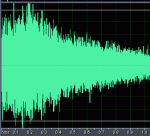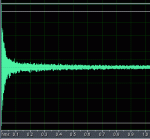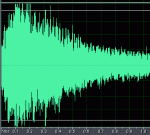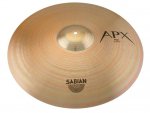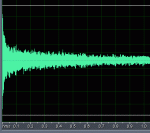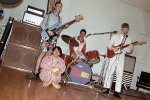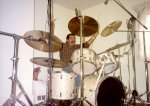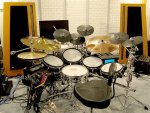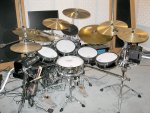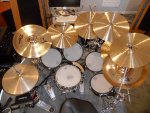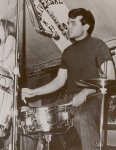J
JEJ
Guest
Hi - I am new to this forum. I am Editor-in-Chief of Secrets of Home Theater and High Fidelity at http://www.hometheaterhifi.com. In the course of reviewing products, I was measuring the frequency spectrum of cymbals (I am also a drummer) using laboratory-grade microphones calibrated to plus or minus 0.5 dB, 20 Hz - 30 kHz. I discovered that cymbals produce frequencies out to 60 kHz in some cases, far beyond what is recorded on CDs. It was also very interesting to see the differences in the spectra for various cymbal types and their rates of decay. So, I decided to start reviewing cymbals, but in far greater detail than you will find in any drum magazine. The reviews will have my overall impression of the sound, accompanied by a full spectrum analysis and a loudness vs time spectrum which shows the decay over time.
I record the cymbals in my test lab, which has absorption panels on the walls and ceiling. There is also wall-to-wall carpet. I have to use a computer to record the samples, so I bought some sound damping panels to place in front of the computer. I place a cymbal stand at the other end of the room as far away from the computer as possible. I use two microphone stands, one on either side of the test cymbal, with the two microphones (Earthworks M30BX) pointed down at a 45 degree angle, at about 40% in from the edge of the cymbal, and about 5 inches distance from the surface of the cymbal. The microphones are highly directional, so their major sensitivity is to sound in front of them, on-axis.
I record the cymbal sounds, either crash or ride, using a 5B hickory drumstick with a nylon tip. For crash cymbals, I strike the cymbal from the front, at a 45 degree angle to the cymbal, perpendicular to the direction that the microphones are pointing in towards the cymbal. I strike it at a strength that one would use when performing (relatively hard). For ride cymbals, I strike the front of the cymbal (one strike) using the nylon tip, with the strength that one would use when riding the cymbal during a performance, again perpendicular to the microphones, at about 40% in from the edge.
I record the cymbal sounds at 176.4 kHz sampling frequency (CDs use 44.1 kHz) and 24 bit depth (CDs have a 16 bit depth). I normalize each sample to 0 dB, which is the upper limit of digital recording. Then, I edit the sample so that the beginning of the sample is at the front edge of the sound (when the stick struck the cymbal) and trim it so that the length of the sample is 2 seconds.
I play the samples in SpectraPlus software, which uses FFT analysis to produce the spectra. The sound card is a Lynx L22, which records and plays digital samples up to 200 kHz sampling frequency and 24 bit depth. In analog audio terms, this means it will record sounds as high as 100 kHz. The microphones are connected to the Lynx card input via XLR so they are balanced, which helps to eliminate any noise picked up by the microphone cable.
In the spectra for the cymbal, you will see two graph lines. The magenta one is the peak sound, i.e., right at the beginning of the cymbal sound. The yellow line is the sound at the end of the sample, i.e., 2 seconds, and it illustrates the decay.
You will also see a graph that shows the sound level over a 1 second time period, from the initial contact of the stick with the cymbal.
I will be loading the reviews one at a time as individual posts in the thread. Feel free to comment and to request reviews of any cymbal you would like to see reviewed here.
John E. Johnson, Jr.
I record the cymbals in my test lab, which has absorption panels on the walls and ceiling. There is also wall-to-wall carpet. I have to use a computer to record the samples, so I bought some sound damping panels to place in front of the computer. I place a cymbal stand at the other end of the room as far away from the computer as possible. I use two microphone stands, one on either side of the test cymbal, with the two microphones (Earthworks M30BX) pointed down at a 45 degree angle, at about 40% in from the edge of the cymbal, and about 5 inches distance from the surface of the cymbal. The microphones are highly directional, so their major sensitivity is to sound in front of them, on-axis.
I record the cymbal sounds, either crash or ride, using a 5B hickory drumstick with a nylon tip. For crash cymbals, I strike the cymbal from the front, at a 45 degree angle to the cymbal, perpendicular to the direction that the microphones are pointing in towards the cymbal. I strike it at a strength that one would use when performing (relatively hard). For ride cymbals, I strike the front of the cymbal (one strike) using the nylon tip, with the strength that one would use when riding the cymbal during a performance, again perpendicular to the microphones, at about 40% in from the edge.
I record the cymbal sounds at 176.4 kHz sampling frequency (CDs use 44.1 kHz) and 24 bit depth (CDs have a 16 bit depth). I normalize each sample to 0 dB, which is the upper limit of digital recording. Then, I edit the sample so that the beginning of the sample is at the front edge of the sound (when the stick struck the cymbal) and trim it so that the length of the sample is 2 seconds.
I play the samples in SpectraPlus software, which uses FFT analysis to produce the spectra. The sound card is a Lynx L22, which records and plays digital samples up to 200 kHz sampling frequency and 24 bit depth. In analog audio terms, this means it will record sounds as high as 100 kHz. The microphones are connected to the Lynx card input via XLR so they are balanced, which helps to eliminate any noise picked up by the microphone cable.
In the spectra for the cymbal, you will see two graph lines. The magenta one is the peak sound, i.e., right at the beginning of the cymbal sound. The yellow line is the sound at the end of the sample, i.e., 2 seconds, and it illustrates the decay.
You will also see a graph that shows the sound level over a 1 second time period, from the initial contact of the stick with the cymbal.
I will be loading the reviews one at a time as individual posts in the thread. Feel free to comment and to request reviews of any cymbal you would like to see reviewed here.
John E. Johnson, Jr.
Last edited:




